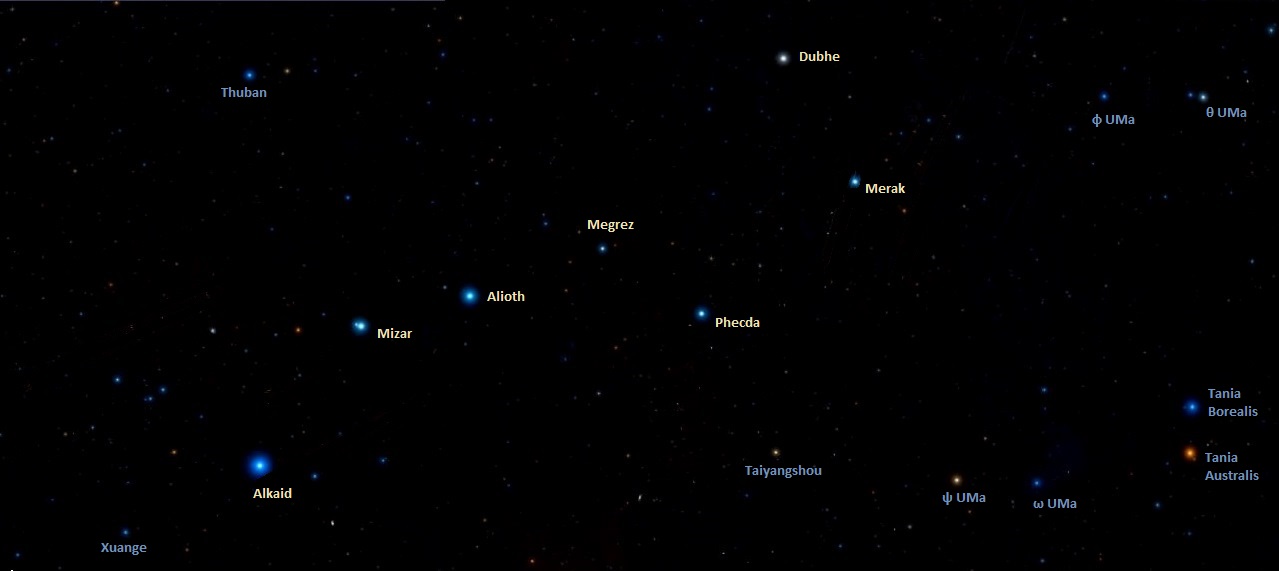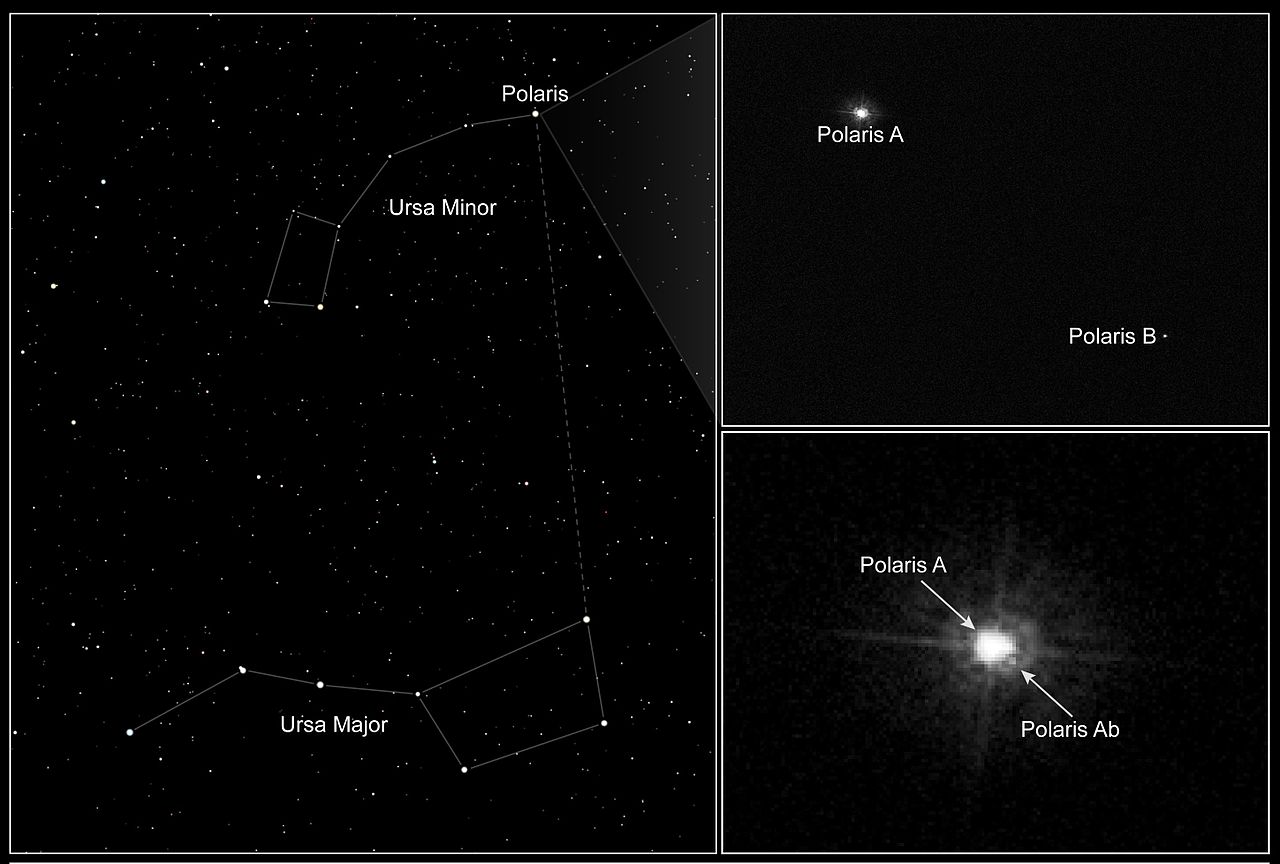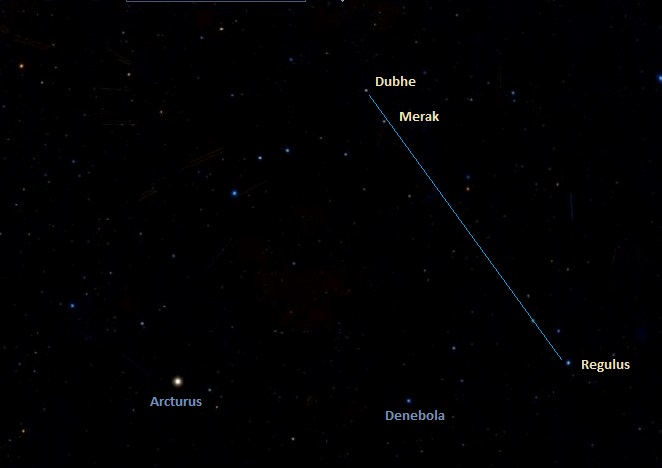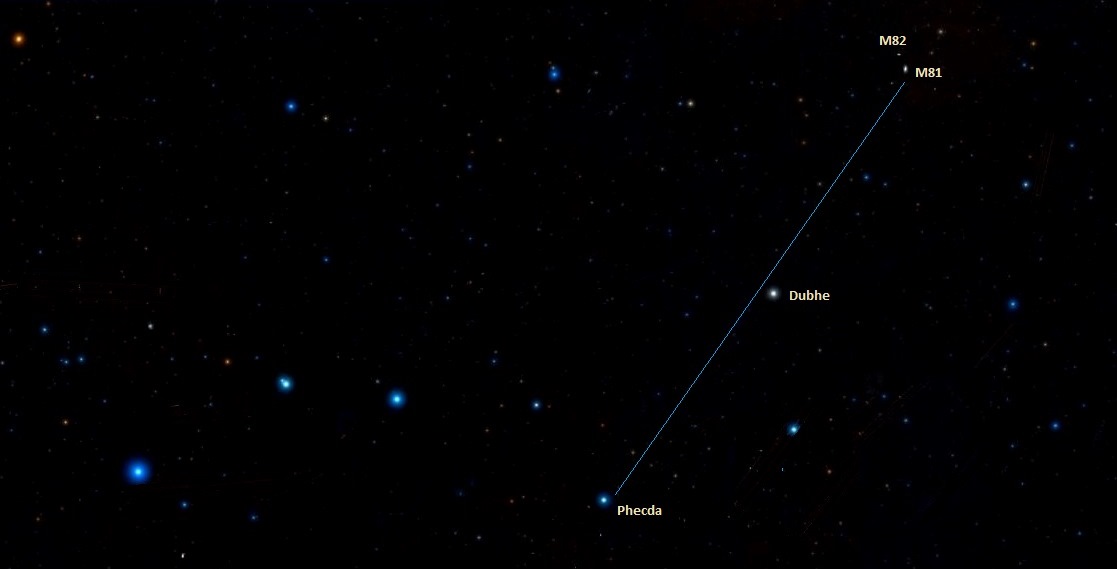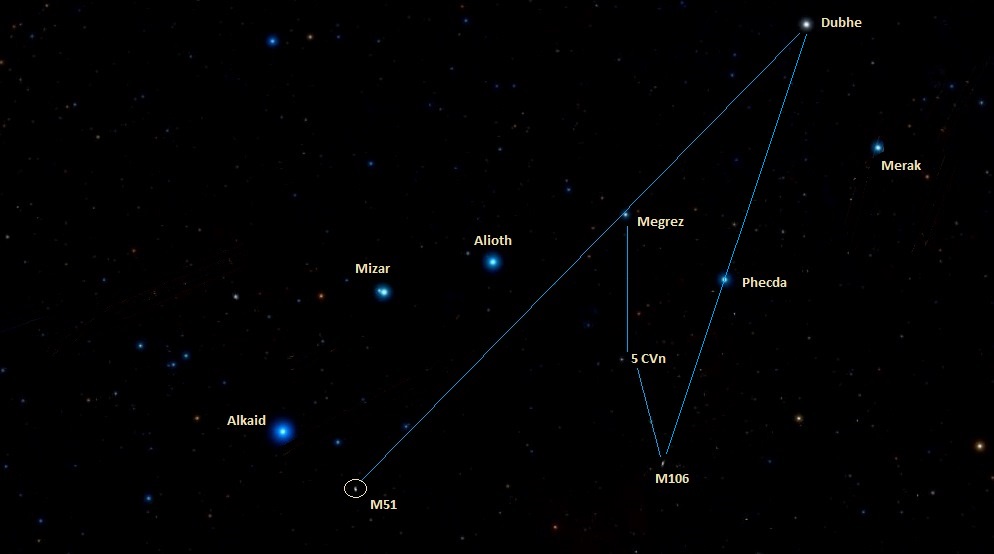Dubhe, Alpha Ursae Majoris (α UMa) is a spectroscopic binary star with an apparent magnitude of 1.79, located at an approximate distance of 123 light years from Earth. It is one of the seven bright stars that form the Big Dipper. Dubhe and its Big Dipper neighbour Merak are known as the Pointer Stars because they are used to find Polaris, the North Star.
Dubhe is the second brightest star in the constellation Ursa Major and the 33rd brightest star in the sky. It shares the 33rd place with Mirfak, Alpha Persei, the brightest star in the constellation Perseus. The two stars are only slightly fainter than Alioth in Ursa Major, Alnitak in Orion and Alnair in Grus, and they just outshine Regor in Vela, Wezen in Canis Major and Kaus Australis in Sagittarius constellation.
Star system
Dubhe is a spectroscopic binary star system consisting of Alpha Ursae Majoris A and Alpha Ursae Majoris B. The primary star, Alpha UMa A, is an orange giant of the spectral type K0III and the companion, Alpha UMa B, is a white hydrogen-fusing dwarf with the stellar classification F0V. Alpha UMa B has an estimated mass of 1.6 solar masses. It completes an orbit around Alpha UMa A every 44.4 years at an average separation of 23 astronomical units. The primary star has 4.25 solar masses and, with a temperature of 4,660 K, it shines with 316 solar luminosities.
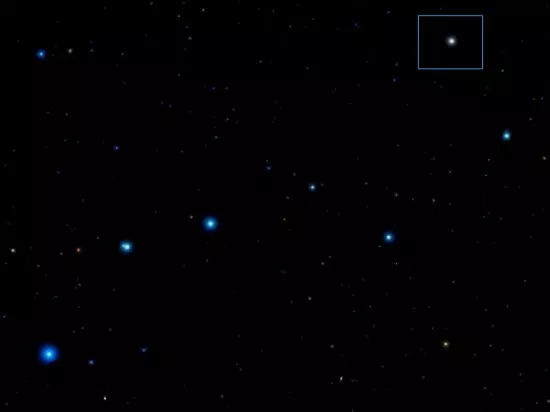
Dubhe (Alpha Ursae Majoris), image: Wikisky
There is another class F star with a spectroscopic companion at a separation of about 8 arcminutes from Alpha UMa A and B. The 7th magnitude system is sometimes called Alpha Ursae Majoris C, but it is in fact considerably more distant from us than Alpha UMa A and B, and catalogued separately as HD 95638. The system has the spectral classification F8 and an orbital period of about 6 days.
Facts
Dubhe is the coolest (4,660 K) and most distant of the Big Dipper stars. It lies at a distance of 123 light years, while most other stars are about 80 light years distant. It is the second most luminous of the seven stars. Only Alkaid, Eta Ursae Majoris, has a greater energy output.
Dubhe is a suspected variable star. Its brightness has been reported to change by a thousandth of a magnitude.
Five Dipper stars – Mizar, Alioth, Merak, Phecda and Megrez – are all class A stars with an estimated age of around 300 million years. They belong to the Ursa Major Moving Group, a group of stars that were formed in the same molecular cloud and share common velocities and motion through space. Dubhe and Alkaid, the easternmost star of the Big Dipper, do not share a common origin with the other stars nor do they have the same proper motion. As a result, the Big Dipper asterism will not stay the same over time and it will eventually dissipate.
Dubhe is one of the three Ursa Major stars selected for navigation. The other two are Alioth and Alkaid. Navigational stars have a special role in the field of celestial navigation and were selected both because they are bright and because they are easy to recognize.
In spite of not being the brightest star in the constellation Ursa Major, Dubhe has the Bayer designation Alpha Ursae Majoris. This is because German uranographer Johann Bayer assigned Greek letters to the constellation’s bright stars going from west to east, and Dubhe is the westernmost of Ursa Major’s brightest stars. Merak, the other Pointer Star, has the designation Beta despite being only the 5th brightest star in the constellation, while Alioth, the constellation’s brightest star, has the designation Epsilon Ursae Majoris because it is located further to the east. It is the star in the tail of the Great Bear closest to its body, or the star in the handle of the Big Dipper closest to the bowl. With a visual magnitude of 1.77, Alioth is only slightly brighter than Dubhe (mag. 1.79).
In the ancient Arabic-speaking world, the stars of the Big Dipper represented a funeral procession. The stars that form the Dipper’s handle – Alkaid, Mizar and Alioth – represented mourners, while the stars of the Dipper’s bowl – Megrez, Phecda, Dubhe and Merak – represented the coffin. Their slow motion around Polaris and the north celestial pole was associated with the slow movement of a funeral procession.
Dubhe became the official star of the State of Utah in 1996. It was selected as the official state star in Utah’s Centennial year because its light takes about 100 years to reach Earth.
Pointer Stars
Dubhe and Merak are known as the Pointer Stars (or simply the Pointers) because they point the way to Polaris and are commonly used to find true north. An imaginary line drawn from Merak through Dubhe and extended by about five times the distance between the two stars leads directly to the North Star. Polaris is the brightest star along this imaginary line.
In the other direction, Dubhe and Merak point toward Regulus, the brightest star in the constellation Leo and the 21st brightest star in the sky. Regulus is easy to identify because it sits at the base of an asterism known as the Sickle, which appears as a backward question mark and outlines the head of the celestial lion.
Name
The name Dubhe (pronunciation /ˈdʌbiː/) comes from the Arabic word dubb, meaning “bear.” It was taken from the phrase żahr ad-dubb al-akbar, which means “the back of the Greater Bear” and indicates Dubhe’s position in Ursa Major. The name was officially approved for Alpha Ursae Majoris A by the International Astronomical Union’s (IAU) Working Group on Star Names (WGSN) on June 30, 2016.
The star’s other traditional name, Ak, means “the eye,” but it has not been as commonly used.
The Chinese know Dubhe as the First Star of Northern Dipper (北斗一). The name refers to the Chinese Northern Dipper asterism, which is equivalent to the Big Dipper. The star’s other Chinese name is Tiān Shū, the Star of Celestial Pivot (天樞).
In Hindu mythology, Dubhe is associated with Kratu, one of the Saptarishi (Seven Sages). Kratu was a Prajapati (Vedic deity) and the son of Lord Brahma.
Location
Dubhe is very easy to find because it is part of the Big Dipper. It is the westernmost star in the asterism, marking the lip of the Big Dipper’s bowl.
Dubhe can be used to find a pair of famous galaxies in Ursa Major. Messier 81, also known as Bode’s Galaxy, lies some 10 degrees northwest of the star. It can be found by extending an imaginary line from Phecda through Dubhe by about the same distance as that between the two stars. The Cigar Galaxy (Messier 82) lies in the same field of view, only 38 arcminutes from M81.
Going in the opposite direction, the spiral galaxy Messier 106 in the constellation Canes Venatici can be located by extending a line from Dubhe though Phecda, while a line from Dubhe through Megrez leads directly to the famous Whirlpool Galaxy (Messier 51), also located in Canes Venatici.
Dubhe and other stars of the Big Dipper are circumpolar, i.e. they never set, to most northern observers and can be seen at any time of year. The Big Dipper is particularly prominent in the northern hemisphere in the months of spring, when it dominates the evening sky.
Constellation
Dubhe is located in the constellation Ursa Major, the Great Bear. Best known for the Big Dipper asterism, Ursa Major is the largest northern constellation and the third largest of all 88 constellations, after Hydra and Virgo. It contains a great number of interesting deep sky objects. In addition to M81 and M82, it is home to the planetary nebula Messier 97, also known as the Owl Nebula, the famous Pinwheel Galaxy (Messier 101), and the barred spiral galaxies Messier 108 and Messier 109.
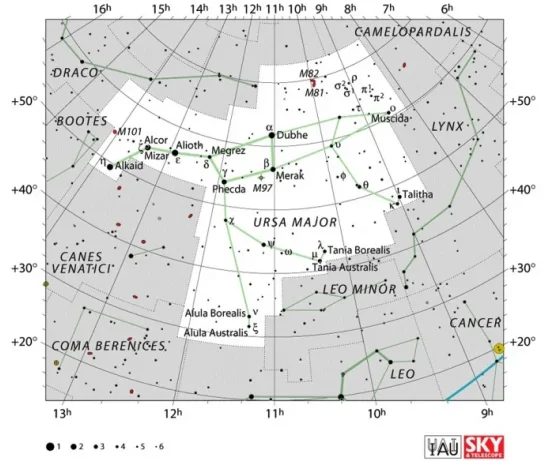
Ursa Major constellation map by IAU and Sky&Telescope magazine
The 10 brightest stars in Ursa Major are Alioth (Epsilon UMa, mag. 1.77), Dubhe (Alpha UMa, mag. 1.79), Alkaid (Eta UMa, mag. 1.86), Mizar (Zeta UMa, mag. 2.04), Merak (Beta UMa, mag. 2.37), Phecda (Gamma UMa, 2.438), Psi Ursae Majoris (mag. 3.01), Tania Australis (Mu UMa, mag. 3.06), Talitha (Iota UMa, mag. 3.14), and Theta Ursae Majoris (mag. 3.166).
Dubhe – Alpha Ursae Majoris
| Spectral class | K0III + F0V |
| Variable type | suspected |
| U-B colour index | +0.93 |
| B-V colour index | +1.07 |
| Apparent magnitude | 1.79 |
| Absolute magnitude | –1.10 ± 0.04 |
| Distance | 123 ± 2 light years (37.7 ± 0.7 parsecs) |
| Parallax | 26.54 ± 0.48 mas |
| Radial velocity | -9 km/s |
| Proper motion | RA: -134.11 mas/yr |
| Dec.: -34.70 mas/yr | |
| Mass (α UMa A, α UMa B) | 4.25 M☉, 1.6 M☉ |
| Luminosity (α UMa A) | 316 L☉ |
| Radius | 30 R☉ |
| Temperature (α UMa A) | 4,660 K |
| Rotational velocity (α UMa A) | 2.6 ± 1.0 km/s |
| Surface gravity | 2.46 cgs |
| Constellation | Ursa Major |
| Right ascension | 11h 03m 43.67152s |
| Declination | +61° 45′ 03.7249” |
| Designations | Dubhe, Alpha Ursae Majoris, α UMa, 50 Ursae Majoris, HD 95689, GC 15185, HR 4301, FK5 417, HIP 54061, SAO 15384, BD+62°1161, PPM 17705, WDS J11037+6145AB, CCDM J11037+6145AB, GCRV 6819, IRAS 11006+6201, 2MASS J11034364+6145034, TYC 4146-1274-1 (α UMa A), TYC 4146-1274-2 (α UMa B) |
